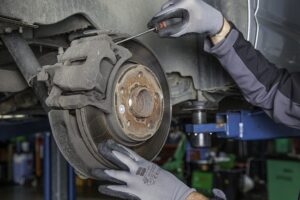Revolutionary advancements in car braking technologies have paved the way for safer journeys on the road. With every passing year, manufacturers are introducing cutting-edge innovations that not only enhance vehicle performance but also prioritize driver and passenger safety.
From automatic engine braking to regenerative braking systems, these breakthroughs have the potential to save countless lives and prevent accidents from occurring. Read on and explore some of the most remarkable car braking technologies that are changing the game and making roads a safer place for everyone involved.
Automatic Engine Braking (AEB)
 Automatic Engine Braking (AEB) is a game-changer in the world of car braking technologies. This innovative system uses sensors and cameras to detect potential collisions ahead and automatically applies the brakes to mitigate or avoid accidents. It works by constantly monitoring the road conditions, distance from preceding vehicles, and the speed at which your vehicle is traveling. By utilizing advanced algorithms beautifully, just like the gina brown’s yarn vancouver, AEB can quickly assess any potential dangers on the road and react faster than human reflexes allow. This means that even if you momentarily lose focus or fail to react in time, AEB will step in to help prevent a collision. One of the most impressive aspects of AEB is its ability to work seamlessly with other safety features.
Automatic Engine Braking (AEB) is a game-changer in the world of car braking technologies. This innovative system uses sensors and cameras to detect potential collisions ahead and automatically applies the brakes to mitigate or avoid accidents. It works by constantly monitoring the road conditions, distance from preceding vehicles, and the speed at which your vehicle is traveling. By utilizing advanced algorithms beautifully, just like the gina brown’s yarn vancouver, AEB can quickly assess any potential dangers on the road and react faster than human reflexes allow. This means that even if you momentarily lose focus or fail to react in time, AEB will step in to help prevent a collision. One of the most impressive aspects of AEB is its ability to work seamlessly with other safety features.
Anti-Lock Braking System (ABS)
On the other hand, ABS is specifically designed to prevent the wheels from being locked up during sudden or hard braking, ensuring drivers are still able to maintain control of their vehicles and avoid accidents. How does ABS work? Well, when you apply the brakes in an emergency, the system quickly monitors the rotational speed of every single wheel. If the wheel is on the verge of locking up and skidding on the road surface, ABS automatically modulates brake pressure to that wheel. This modulation happens within milliseconds and allows for maximum braking force while still enabling steering control. The best thing about ABS is it can significantly reduce stopping distances on both wet and dry surfaces. This can mean the difference between a near-miss and a collision. By preventing wheel lock-up, ABS helps drivers maintain directional stability while braking.
Electronic Brakeforce Distribution (EBD)
 One of the main advantages of EBD is its ability to enhance stability and control while braking. By adjusting the brake pressure according to various factors such as vehicle load, speed, and road conditions, EBD ensures that each wheel receives just the right amount of stopping power. This not only reduces skidding but also improves overall handling and maneuverability. Furthermore, EBD works in tandem with other advanced braking technologies like the Anti-Lock Braking System (ABS). While ABS prevents individual wheels from locking up by modulating brake pressure rapidly, EBD takes it a step further by dynamically adjusting this pressure distribution based on real-time inputs from sensors placed throughout the vehicle. As technology continues to advance, car braking technologies have experienced significant innovations that can potentially save countless lives on the road. These advancements in braking systems aim to enhance driver safety, improve vehicle control, and reduce the risk of accidents.
One of the main advantages of EBD is its ability to enhance stability and control while braking. By adjusting the brake pressure according to various factors such as vehicle load, speed, and road conditions, EBD ensures that each wheel receives just the right amount of stopping power. This not only reduces skidding but also improves overall handling and maneuverability. Furthermore, EBD works in tandem with other advanced braking technologies like the Anti-Lock Braking System (ABS). While ABS prevents individual wheels from locking up by modulating brake pressure rapidly, EBD takes it a step further by dynamically adjusting this pressure distribution based on real-time inputs from sensors placed throughout the vehicle. As technology continues to advance, car braking technologies have experienced significant innovations that can potentially save countless lives on the road. These advancements in braking systems aim to enhance driver safety, improve vehicle control, and reduce the risk of accidents.

